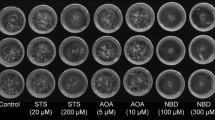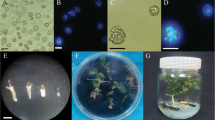Abstract
The objective of this study was to determine the effect of induction medium osmolality on embryogenesis and green plant production in wheat and triticale. Isolated microspores of wheat and triticale were subjected to a range of osmolality (300–500 mOsm kg−1) using mannitol. In both species, the maximum number of embryo-like structures (ELS) and green plants were obtained at 350 mOsm kg−1 when the induction medium was supplemented with 9.1 g L−1 of mannitol. A sharp decline in microspore response was observed at higher osmolality. These results demonstrate the effect of osmolality on induction of ELS and production of green plants indicating that the process of microspore embryogenesis can be improved in wheat and triticale by increasing osmolality of the induction medium to 350 mOsm kg−1.




Similar content being viewed by others
References
Attree SM, Fowke LC (1993) Embryogeny of gymnosperms—advances in synthetic seed technology of conifers. Plant Cell Tissue Organ Cult 35:1–35
Ayed OS, Buyser JD, Picard E, Trifa Y, Amara HS (2010) Effect of pretreatment on isolated microspores culture ability in durum wheat (Triticum turgidum subsp. durum Desf.). J Plant Breed Crop Sci 2:30–38
Cistue L, Romagosa I, Batlle F, Echavarri B (2009) Improvements in the production of doubled haploids in durum wheat (Triticum turgidum L.) through isolated microspore culture. Plant Cell Rep 28:727–735
Cistue L, Soriano M, Castillo AM, Valles MP, Sanz JM, Echavarri B (2006) Production of doubled haploids in durum wheat (Triticum turgidum L.) through isolated microspore culture. Plant Cell Rep 25:257–264
Cram WJ (1984) Mannitol transport and suitability as an osmoticum in root-cells. Physiol Plant 61:396–404
Custers JBM (2003) Microspore culture in rapeseed (Brassica napus L.). In: Maluszynski M, Kasha KJ, Forster BP, Szarejko I (eds) Doubled haploid production in crop plants: a manual, 1st edn. Kluwer, Dordrecht Netherlands, pp 185–194
Delaitre C, Ochatt S, Deleury E (2001) Electroporation modulates the embryogenic responses of asparagus (Asparagus officinalis L.) microspores. Protoplasma 216:39–46
Diamond JM, Wright EM (1969) Biological membranes—physical basis of ion and nonelectrolyte selectivity. Annu Rev Physiol 31:581–646
Eudes F, Acharya S, Laroche A, Selinger LB, Cheng KJ (2003) A novel method to induce direct somatic embryogenesis, secondary embryogenesis and regeneration of fertile green cereal plants. Plant Cell Tissue Organ Cult 73:147–157
Ferrie AMR (2003) Microspore culture of Brassica species. In: Maluszynski M, Kasha KJ, Forster BP, Szarejko I (eds) Doubled haploid production in crop plants: a manual, 1st edn. Kluwer, Dordrecht Netherlands, pp 205–215
Garrido D, Chibi F, Matilla A (1995) Polyamines in the induction of Nicotiana tabacum pollen embryogenesis by starvation. J Plant Physiol 145:731–735
Grewal RK, Lulsdorf M, Croser J, Ochatt S, Vandenberg A, Warkentin TD (2009) Doubled-haploid production in chickpea (Cicer arietinum L.): role of stress treatments. Plant Cell Rep 28:1289–1299
Guo YD, Pulli S (2000) Isolated microspore culture and plant regeneration in rye (Secale cereale L.). Plant Cell Rep 19:875–880
Hoekstra S, Vanzijderveld MH, Heidekamp F, Vandermark F (1993) Microspore culture of Hordeum vulgare L.—the influence of density and osmolality. Plant Cell Rep 12:661–665
Hu TC, Kasha KJ (1999) A cytological study of pretreatments used to improve isolated microspore cultures of wheat (Triticum aestivum L.) cv. Chris. Genome 42:432–441
Immonen S, Robinson J (2000) Stress treatments and ficoll for improving green plant regeneration in triticale anther culture. Plant Sci 150:77–84
Kaur P, Bhalla JK (1998) Regeneration of haploid plants from microspore culture of pigeon pea (Cajanus cajan L.). Indian J Exp Biol 36:736–738
Konzak CF, Polle EA, Liu W, Zheng Y (1999) Methods for generating doubled-haploid plants. US Patent No. US6362393
Kumlehn J, Serazetdinova L, Hensel G, Becker D, Loerz H (2006) Genetic transformation of barley (Hordeum vulgare L.) via infection of androgenetic pollen cultures with Agrobacterium tumefaciens. Plant Biotechnol J 4:251–261
Levene H (1960) Robust tests for equality of variances. In: Olkin I, Hotelling H (eds) Contributions to probability and statistics. Stanford University Press, Palo Alto, CA, pp 278–292
Lichter R (1981) Anther culture of Brassica napus in a liquid culture-medium. Zeitschrift Fur Pflanzenphysiologie 103:229–237
Lionneton E, Beuret W, Delaitre C, Ochatt S, Rancillac M (2001) Improved microspore culture and doubled-haploid plant regeneration in the brown condiment mustard (Brassica juncea). Plant Cell Rep 20:126–130
Massey FJ (1951) The Kolmogorov–Smirnov test for goodness of fit. J Am Stat Assoc 46:68–78
Mix G, Wang HM (1988) Invitro production of haploid cowpea plants (Vigna unguiculata L). Landbauforsch Volk 38:305–309
Ochatt S, Pech C, Grewal R, Conreux C, Lulsdorf M, Jacas L (2009) Abiotic stress enhances androgenesis from isolated microspores of some legume species (Fabaceae). J Plant Physiol 166:1314–1328
Roberts OSL, Dunwell JM (1990) Barley anther culture: pretreatment on mannitol stimulates production of microspore-derived embryos. Plant Cell Tiss Organ Cult 20:235–240
SAS (2003) Release 9.2. SAS Institute Inc, Cary, NC, USA
Steel RGD, Torrie JH, Dickey DA (1997) Principles and procedures of statistics: a biometrical approach. McGraw Hill, New York, USA
Trip P, Krotkov G, Nelson CD (1964) Metabolism of mannitol in higher plants. Am J Bot 51:828–835
Wojnarowiez G, Caredda S, Devaux P, Sangwan R, Clement C (2004) Barley anther culture: assessment of carbohydrate effects on embryo yield, green plant production and differential plastid development in relation with albinism. J Plant Physiol 161:747–755
Xie JH, Gao MW, Cai QH, Liang ZQ, Xue QZ (1996) Effects of donor plant growth status and preculture temperature on isolated microspore culture ability in japonica rice (Oryza sativa L). Cereal Res Commun 24:133–138
Xu N, Coulter KM, Bewley JD (1990) Abscisic-acid and osmoticum prevent germination of developing alfalfa embryos, but only osmoticum maintains the synthesis of developmental proteins. Planta 182:382–390
Zhao GL, Liu YZ, Yin AP, Li JB (1998) Germination of embryo in soybean anther culture. Chin Sci Bull 43:1991–1995
Zheng MY, Weng Y, Sahibzada R, Konzak CF (2003) Isolated microspore culture in maize (Zea mays L.) production of doubled-haploid via induced androgenesis. In: Maluszynski M, Kasha KJ, Forster BP, Szarejko I (eds) Doubled haploid production in crop plants: a manual, 1st edn. Kluwer, Dordrecht, pp 95–102
Zhou H, Zheng Y, Konzak CF (1991) Osmotic potential of media affecting green plant percentage in wheat anther culture. Plant Cell Rep 10:63–66
Acknowledgments
The research reported in this paper was supported by Western Grains Research Foundation, Canadian Wheat Board and Alberta Crop Industry Development Fund.
Author information
Authors and Affiliations
Corresponding author
Additional information
Editor: J. Forster
Rights and permissions
About this article
Cite this article
Asif, M., Eudes, F., Randhawa, H. et al. Induction medium osmolality improves microspore embryogenesis in wheat and triticale. In Vitro Cell.Dev.Biol.-Plant 50, 121–126 (2014). https://doi.org/10.1007/s11627-013-9545-5
Received:
Accepted:
Published:
Issue Date:
DOI: https://doi.org/10.1007/s11627-013-9545-5




